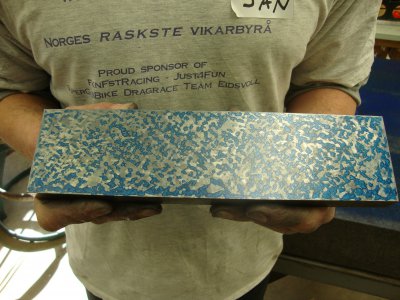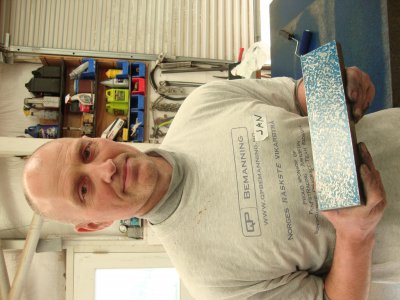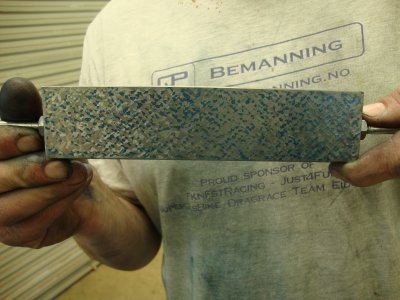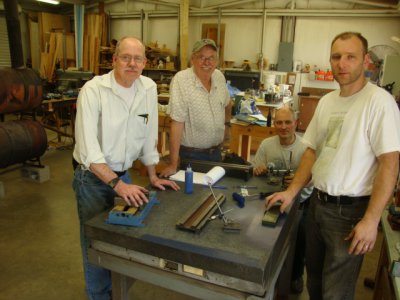- Joined
- Jul 1, 2012
- Messages
- 1,356
Hi all,
greetings to my "classmates" from the Georgia scraping class and our mentor R.King.
I have been trying to hone my scraping skills, as best I have had the time to (my friends camelback.. happens to be just the thing we practised, ie. one surface flat and to 40 ppi). I learned a lot in Georgia, something I would never have done without Richards teaching. I hope I will do him right with my efforts on my projects.. Another side of the class experience was that I had a he.. of a good time! Better vacation I could not have had.
One major project I have aquired is a Schaublin SV52 mill, details found at http://www.lathes.co.uk/schaublinmiller/page5.html (thanks to my friend Ola, who convinced me that I just had to have this mill, as can be seen by his grinning face after I had been talking with the salesguy at the local Danish machine dealer..)View attachment 54691
I did try the machine somewhat before committing, but as Ola proclaimed "it cannot be much used as there is hardly no paint chipped off.." hmm..the machine is a good 50 years old How well do you know Ola? That looks more like a "grin" then a smile...ha ha...is his brother the machine dealer? ha ha....Who took the picture, the dealer? The old owner may have used it very heavy for 1 year and it sat for 49 years in his storage.... ha ha (just kidding)
View attachment 54692pic of the mill in my garage, having been delivered by the typical Danish freight company driver working in slippers, truck with summer tires (down to my place went well, but in Oslo in the hillside in wintery conditions to where he went..?)
Well, to put it short, I have found both wear and breakage (as would be expected). You Danes are know for your relaxed (easy) state right? Slippers...ha ha ha that's funny
Listing as goes:
- The casting holding the brass nut for the in/out table feed was almost broken off, and parted entirely when I put it to the test.
A good lesson to block the machine between the top of table and column and top ram or spindle head. a 4' x 4" wood block. The used machine dealer should have know this. Ask him to pay for the cracked casting. Did your friend run the machine under power? When you buy a used car, do you take it for a test drive? Or just look at it?
One part is still stuck to the underside of the bigger part that onto which the table rests/slides. I have not yet been able to solve the puzzle of how to get apart, but I hope I am in for a "AHA!" experience. Anyway, the 2 cast iron parts are candidates for either brazing or welding together.. We'll see. That is a fix that may be held off until later. Update! I am told it is also possible to "nest the parts together" using Metalock. Ie. no heating, welding or traditional stuff.. sounds too good to be true.. will investigate further as there is a local Metalock company in my city. I have heard of it being used in big expensive castings. I would have it brazed by a pro. Look at the CA class or South Bend forum under "Ulma Doctor" he can tell you how to brazehe did some sweet work to his south bend compound.
- a couple of broken nuts/screw remaindings in holes etc. Not the biggest problems I would also do what Jim did check with the factory and see if you can buy new parts. Sometimes it sounds expensive, but when you spend hours making or fixing something a new one is worth the expense.
- Some more or less rusty parts. Also not much concern
- a lot of grime and dirt, as well as a good portion of greas/oil/swarf mixture.. again, no problem, just work..
- Then onto the topic that is more interesting, namely how much work is needed to restore it to its' former accuracy..
The old lady is Swiss, and on the heavy side at 1200Kg (2600lbs), so she's hard to wrestle around. I have plans to get her on her back having undressed her down to the bare neccessities.. that is, scraping the column ways et. Please be safe, buy, rent, make a A-Frame hoist to lift things (portable crane) or check with a local rigging company or tow truck operator to help you do it.
One thing I see you did not mention was the top round slide. be sure to check it and the rotating heads.
She may have a coat of fresh paint, but I am no artist, so if it can be avoided..Jim is a pro at painting as he does his antique cars. I would clean it and use a paint roller like we used for the ink and a quality paint brush, use a good quality primer and oil based paint. I have also used a Wagner electric paint sprayer, but it takes more work. Air painting makes a cloud of vapor and inside an attached garage will flow into your home...
The table sideways measurements shows about +/-5/100 (2/1000") deviation from center. To my knowledge, the table itself is bowed, and "hangs" down on each side by this amount. This is confirmed by setting a level on the table which proves it is high in the middle. Pic show one of the table flatness tests (I did front, middle and back as well as crosswise all corners, all the same results). Right, Richard. I think I mentioned the Professor who says the tables bend do to the peening of the tee slots and stretching the top of the table when they tightened the vise and parts down. He is right but I also believe it bends after years of unsupported travel or leaving it extended out unsupported for long periods of time. You may want to have the table top machined or ground and see if it bends back. You could scrape it, but it would not look original, you said the scraping on table? Was the table scraped for accuracy or was it just flaked / scraped for cosmetic looks?. If you are short of funds now scrape it as .002" 2/1000 isn't real bad. If you want to bring it back to new, it should be straight and parallel all over, dovetails, top sides, bottom flat's .0002"/12" 2/10000 in 12". The machine could be classified as super precision too and if it is .00005" / 12" 50 millionths in 12". Have to check that out with a sales catalog or a call to the factory.. I am assuming they are still in business?
View attachment 54693
The underside of table, ie. table ways, are pretty flat, though the scrapemarks are almost gone. I also measured the box ways after I had removed the table, leaving the knee ways exposed. In/out travel seems OK, ie. almost no difference. The horisontal ways seems to have seen less wear, and these seem flat and parallel. The main errors are in the vertical box ways. The knee slopes towards the left and out. Going down there is about 20/100 mm (8/1000") movement to the left from top to bottom (45 cm) and about 25/100 mm (10/1000") out.
Yes you need to do more detective work here and discover what ways are touching when new and what ones are clearance. To be honest I have never scraped this type of mill, but it is the same as others in the way it works Many times the center ways are the guiding ways and the outside ways are clearance. The gib screw maybe out of adjustment and you may need to put a temporary shim behind it to make your tests. You can mic the column ways at the top and bottom and these area are normally never worn and are original. Measure them and then in the middle. Remember what I said, measure clearance surfaced as they were machined at the same time as the ways and you can use them as a guide to find out the wear in the ways. Remove the sheet metal guards, those surfaces under there were machined at the same time the ways were machined and use a surface gage to measure from them to the ways. Be a detective, measure twice and cut once as the old saying says. You maybe able to write the factory and get the new machine inspection sheets to follow. Oh did you have your blade square tested?
View attachment 54697
The column has box ways, with the gib on the right (inside) of the left way as seen from the front. With this gib drawn in tight, there is still room for a 10/1000" feeler gage on the opposite side of the left way (same ways as the gib). This is probably because the left side of the righthand way also bears, so no matter if the gib is tight, there is still play. The top side of both keep-plates behind the ways also have play, indicating signs of wear of the mating members here, ie. the back of the ways?
The left side box way is higher than the right side, so it won't "sit" directly on the granite table. Therefore it seems easier for me to scrape the horisontal box ways while the knee is fixed to the column. See above on horizontal ways. I would say after you match fit the back of the knee and fit the rear hold downs I would also scrape the top of the knee on the machine so I can measure the squareness as the machine sets when it is assembled with the knee feed screw. You will want to leave the front of the knee plus at least .0001 to .0002" + in 12" so as you load the saddle and table on the knee it will sag from the weight. You may want to call the factory and ask them this question too. If the back of the knee has a worn area next to an original no worn area, depth mic this and if the wear is very bad, then you may want to make the front of the knee + .0005 to .001" plus. Also check to see if the oil holes are plugged. or pump to the back of knee is broken while being the detective as no oil could make it wear so bad. It might be possible the company who owned the machine seldom used the table, but bored holes feeding the knee up on a production job. Maybe you can call the used equipment dealer or look at the manual and discover who owned it before and give them a phone call and ask about the history of the machine. The picture below does not show way wipers as the one showing the front of the saddle. Is the way wipers on the Z Horz. ways? From the photo's I can't see where the gib is located and the opposite positive side on the knee where it touches or guides.
View attachment 54698
Scraping this will be a challenge with the stepped top, I will have to think about that, to get it square with the Z ways You may ask the factory how thick a shim to set under the one side of the square. Or use the saddle and straight-edge in combination to scrape the top of knee and set the square on the top of the saddle to measure with the blade square. I will let you know after I think about it. But if you measure the ends like I said and scrape off the same amount off each side and re-measure it as you scrape should keep it original...hmmmm this should work. Set the square on a parallel and gage block (s) to span the top ways. Remember what I said about straight oil grooves? You can see the area where the bottom of the saddle has straight grooves and left high areas on the top of the knee. Builder now seldom use straight oil groves in new machines because of that problem. You readers need to always put in diagonal oil groves in as they wear the complete matching way.
Is this OK practise? Out of lazyness, since the knee is already sitting there, I thought maybe I could scrape the horisontal ways first. OK? I guess this would void the term "building the house from the foundation and up"? Ie. normally you start at the bottom and work up: First remove the knee and scrape the column, then the mating member, then mount back the knee. See above.
Also, from your experience, which of the box way surfaces are clearance, if any? Left vertical way bears both sides, but is the right way meant to have clearance on one side? See above, measure the ends where they seldom wear and the clearance surface next to the wear ways.
Many questions, and I know you're progressed to another scraping class, but I thought you might like to hear from me... Kind rgds, Jan Sverre[/QUOTE
This will be a great learning project. Do your homework and clean the machine very well. Make sure to clean the dirty worn parts as you remove them and store them in plastic bags with labels. Never use a paper box, use a tin or plastic container. Check with the factory on what new parts cost. They will be more likely to give you engineering help if you buy new parts from them.
Take some more photo's and please ask more questions. You may also want to find a local retired machine rebuilder to help you. He might be sitting at home bored and would help for free, just to have fun again. Thanks Jan and have a great time scraping, Rich)
I attached some pic's of Jan that was taken last month in Georgia while he took my scraping class.
PS: I did not edit the other guys post, I hit the wrong "edit" post at the bottom of his post, thinking it was mine. OOoopppps , sorry.




Last edited by a moderator:
